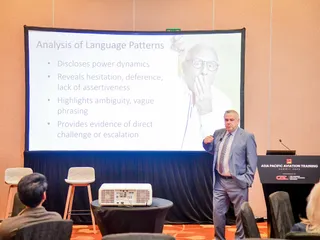Mind Your Language: APATS Safety Strategy
Contact Our Team
For more information about how Halldale can add value to your marketing and promotional campaigns or to discuss event exhibitor and sponsorship opportunities, contact our team to find out more
The Americas -
holly.foster@halldale.com
Rest of World -
jeremy@halldale.com

Key Takeaways
- Workplace power dynamics create safety risks when junior staff hesitate to challenge senior colleagues' decisions
- Language patterns can predict and identify unsafe workplace dynamics through hesitation, vague phrasing, and deference
- Graded assertiveness training using the CUSS model (Concerned, Uncomfortable, Safety issue, Stop) builds confidence
- AI-powered simulation environments allow safe practice of assertiveness skills without real-world consequences
- Failure to follow procedures often stems from workplace norms, time pressure, and cultural deference to authority
- Assertiveness training focuses on evidence-based communication rather than acquiescence to authority
At the Asia Pacific Aviation Training Summit (APATS) 2025 in Singapore, Denis Manson, Technical Director of Ten Hammers Digital Training, and Anne Lomperis, Chief Solution Partner at Language Training Designs, presented groundbreaking research on using language analysis and AI simulation to address critical safety issues in aviation maintenance: authority gradient and failure to follow procedures.
Interested in today’s key issues in aircraft maintenance? Join us at EATS this November to explore more. Learn more here.
The Hidden Safety Challenge
While the aviation industry has long recognized authority gradient issues in flight operations, the maintenance sector faces similar challenges that receive less attention. Manson explained that authority gradient manifests "where a junior person is reluctant to challenge the authority of a more senior person," leading to situations where they fail to speak up when they observe potentially unsafe conditions.
The problem stems from multiple sources: cultural issues where respect for experienced personnel is paramount, organizational hierarchies based on seniority, and individual personality traits that make some people naturally reluctant to challenge authority.
Language as a Safety Predictor
The research team discovered that language patterns in workplace conversations can reveal dangerous authority dynamics. Lomperis, a language specialist who has worked in aviation maintenance English since 2017, noted that "another focus for language in the labor force is to make the use of language on the job more effective for all sorts of goals and purposes. These include safety, efficiency, accuracy, co-worker relations, and relations between superior and subordinate."
By analyzing conversation transcripts, researchers can identify hesitation, deference to experienced personnel, and lack of assertiveness. "[Such] language highlights ambiguity and vague phrasing. So, if somebody's not assertive enough to speak up to authority, you can see this manifested in their language," Manson explained.
Common warning phrases include statements like "It's probably nothing, but should we investigate this?" or "Do you think we should?" These patterns indicate a lack of confidence in challenging potentially unsafe situations.
Case Study: The Burnt Smell
The presentation featured detailed case studies comparing assertive, vague, and silent responses to safety concerns. In one scenario, a junior technician notices a burnt smell from an avionics bay and must decide how to communicate this to a senior colleague.
The assertive response demonstrates clear, evidence-based communication: "I noticed a burnt smell that could be coming from the avionics bay. It's not strong, but it's unusual. I recommend we should open it up and investigate further before you release the aircraft."
When challenged by the senior technician, who dismisses the concern, the assertive communicator persists: "Well, I understand it might be minor but given the location and safety focus of our organization, I believe we need to take a closer look. Can we just take 10 minutes to verify?"
In contrast, vague language produces inadequate results: "Sam, there's a kind of weird smell in the cockpit. [This reference to the cockpit, in general, instead of the more specific reference to the avionics bay, does not sound as professionally commanding, technically knowledgeable, or specifically evidence-based.] Maybe it's nothing, but I thought I'd mention it." This approach allows the senior person to dismiss the concern with minimal investigation.
The silent option results in no action at all. Here, the junior person thinks, "Sam probably already noticed that same smell that I smelled. I'm still new. I don't want to rock the boat."
The CUSS Model for Graded Assertiveness
Drawing from aviation's cockpit resource management practices, the researchers applied the CUSS model to maintenance situations. This graduated intervention approach progresses through four levels:
- Concerned: "I'm concerned about walking under this suspended load"
- Uncomfortable: "I'm uncomfortable continuing without pulling the right circuit breakers"
- Safety issue: "In my opinion, this has escalated into a safety issue"
- Stop: “I’m going to get the torque wrench.” – as definitive action to use the prescribed tool for the procedure, so as to halt an unsafe activity using the wrong tool
Case Study: The Torque Wrench Dilemma
A second case study illustrated graded assertiveness in procedure compliance. Here, a senior technician ceates a rationale for not using the specified, procedural tool, leaving a junior colleague to face a classic authority gradient challenge. The senior technician affirms that ,"We don't need the torque wrench for this job. I've done it hundreds of times [with a hand spanner, not the prescribed tool]. You can feel when it's right."
Using graded assertiveness, the response of the junior colleague progresses from concern ("But Sam, I'm concerned. The manual does say we need to torque the bolts"), to discomfort ("I was trained to always follow torque specifications... I'm uncomfortable skipping that task"), to safety assertion ("I believe it is a safety issue. I'd be much happier if we comply with the approved data.”), to taking an action to stop or halt the unsafe activity (“I'm going to get the torque wrench").
AI-Powered Training Solutions
The research team developed an immersive AI environment to practice assertiveness skills safely. Manson described their system: "We've created a simulated environment at the moment for language training. We have a mentor who guides a person through tasks within this maintenance environment and provides advice and counseling for young trainees."
The AI system can analyze language patterns to provide real-time feedback on assertiveness levels and communication effectiveness. "Extracting this data is where the AI comes in," Manson noted, explaining how the technology can identify communication patterns of concern and suggest improvements.
Benefits of Simulation Training
The simulated environment offers several advantages for assertiveness training:
- Safe practice space: No real-world consequences for mistakes
- Repetitive learning: Multiple opportunities to practice difficult conversations
- Emotional detachment: Reduces anxiety about challenging authority figures
- Objective feedback: AI analysis removes human bias from evaluation
However, the researchers acknowledged limitations: "AI is not very good at this nuanced, you know, human side of human-to-human interaction, emotion of the situation."
Evidence-Based Communication Strategy
The training emphasizes focusing on data and evidence rather than emotional dynamics. "Assertiveness shouldn't be about confrontation. It's not about a power struggle. It's about clarity, confidence, and the safety of the operation," Manson stressed.
Key strategies include:
- Acknowledging the senior person's experience while maintaining safety concerns
- Focusing on mutual decision-making rather than individual authority
- Using specific technical documentation to support positions (or assertions?)
- Presenting evidence objectively without personal attacks
Future Diagnostic Capabilities
The research team identified two promising areas for future development: confidence scoring based on language analysis, and language performance benchmarking to measure improvement over time. These tools could provide quantitative measures of assertiveness development and identify individuals who need additional support.
Cultural Change Requirements
Implementing assertiveness training also requires addressing resistance from senior personnel who may view it as challenging their authority. The researchers emphasized that "communication is a safety tool" and that "flattening the gradient saves lives," drawing parallels to successful cockpit resource management programs.
Broader Impact
While some maintenance situations may not be immediately life-threatening, the research addresses both safety and efficiency concerns. "We're talking about workplace safety. We're also talking about efficiency," Manson explained.
The work of these researchers represents a significant step toward addressing the global maintenance technician shortage by improving workplace communication and reducing incidents caused by authority gradient issues. As Lomperis noted, effective language training "enables us to recruit more widely into non-native English-speaking populations," while improving overall job performance across safety, efficiency, and interpersonal relationships.
This research demonstrates how combining language analysis, AI technology, and proven aviation safety principles can address longstanding challenges in maintenance operations, potentially saving lives and improving industry efficiency through assertiveness training for better communication.
Mind Your Language: APATS Safety Strategy AI-Generated; © Denis Manson & Anne Lomperis (reviewed/edited), 9-7-25
The conversation on aircraft maintenance will continue at the European Aviation Training Summit (EATS), where industry experts will lead a roundtable discussion on Engaging and Empowering the Next Generation of Maintenance Personnel. The session will explore strategies to attract, train, and retain future maintenance professionals, addressing workforce challenges and ensuring sustainable growth for the sector.
Register for EATS 2025!.png/r%5Bwidth%5D=320/17954010-9233-11f0-a497-e3df816d9f32-Screenshot%202025-09-15%20at%2013.webp)

